May 2016 – The Canadian Rockies are a huge mountain range, and at their heart there is a cluster of four adjacent National Parks (a few more National Parks are tucked into other regions in the range). After spending a little time in Fernie and Invermere on our way north from Glacier National Park in Montana, we entered Kootenay National Park and purchased an annual Parks Canada Discovery Pass for C$136.40 (about $100 US) on our way in.
Because Canada is celebrating its 150th year of confederation in 2017, all the National Parks entrance fees will be waived in 2017. So, the ranger happily informed us that our 2016 pass is effective for two years, which is another way of looking at it. Either way, it was a deal because we knew we’d be enjoying these parks for a while this year and, who knows, maybe next year too!
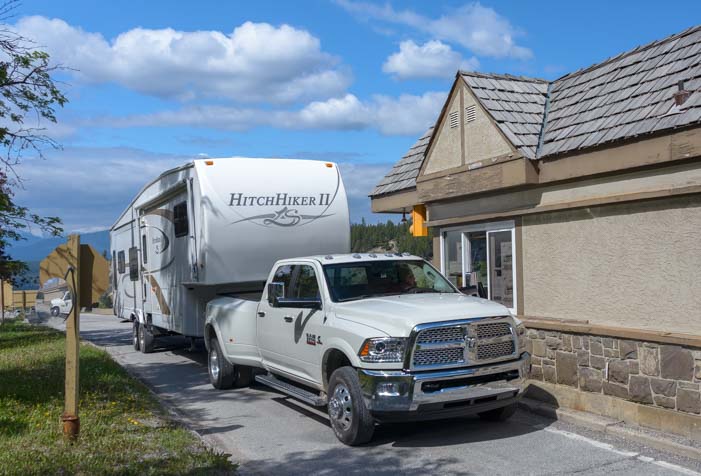
Knowing we’d be in Canada’s National Parks for a while, we bought a Discovery Pass as we drove into Kootenay National Park near Radium Hot Springs
The Rockies are in your face as you drive on the highway through Kootenay National Park, and what a fabulous thing to have in your face! Even though the weather turned cloudy and gray as we drove, the mountains were breathtaking.
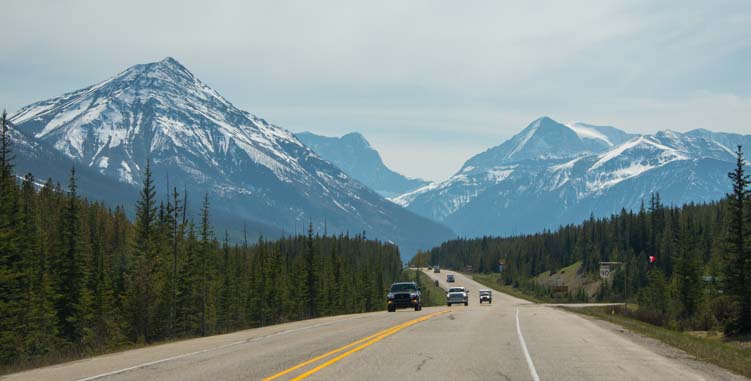
The weather wasn’t cooperating, but the mountains were astonishing.
Highway 93 travels in the valleys between the towering mountains in Kootenay national Park, first along the Kootenay River and then along the Vermillion River. We stopped at one point when the turquoise color of the water in the river jumped out at us from the side of the road.

We drove by this gorgeous turquoise water and just had to stop for a photo!
We were entering serious bear country, and every souvenir shop and hiking shop we’d visited so far in Canada had funny t-shirts or cards about the danger of these frightening beasts. I couldn’t help but get pics of a few.

.

.

.
There was a definite theme here: don’t get chased by a bear or you’ll be toast. Or lunch!
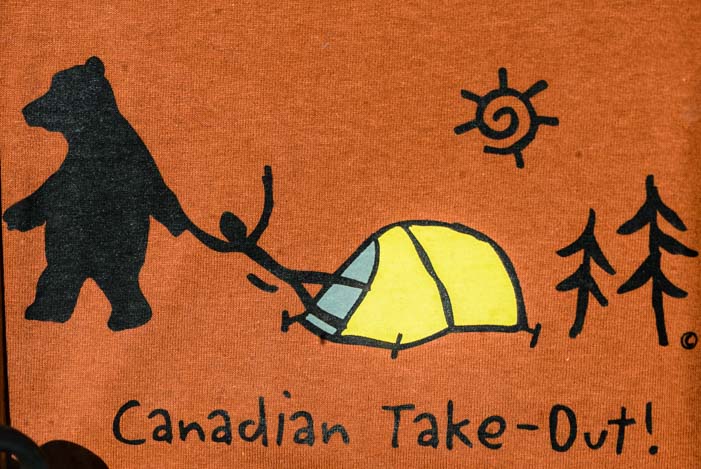
.

.

.
One thing that is sold everywhere is bear spray. This is a mace-like spray that will keep you safe if a grizzly rears up on its hind legs and comes after you, claws pawing the air and roaring. Or so they say. I try to imagine being faced with an angry, hungry bear towering over me and having the presence of mind to remember where my bear spray is and to get it aimed and sprayed in the right direction.
“Hold it right there, Yogi, while I get my bear spray out of my back pack and aim it at you…hmmm… I know it’s in here somewhere!”

.
But with so much excitement about bears, we knew we’d have to see some somewhere. Eventually.
As we had discovered just a few miles south of here, when a group of big horn sheep crossed the highway in front of our truck, it is a common occurrence for animals to cross the highways in this part of the world. It is so common, in fact, that there is an automated detection system that notices when the animals are crossing the highway and lets drivers know.
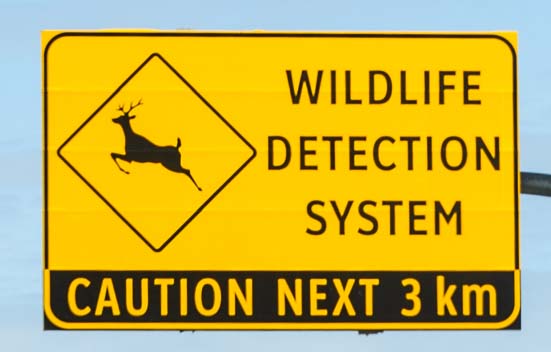
We need this for our cameras!!
There were lots of signs about bears on the highway as we drove through Kootenay National Park, and the ranger at the entrance station had actually given us a slip of paper that talked about them and talked about not getting out of the car in certain sections of the highway.
“The bears have just come out of hibernation,” she explained, “and they’re hungry.”
We figured there was little chance we’d see a bear on the highway and thought nothing of this when, all of a sudden, off in the distance, we saw a big black animal eating dandelions. We slowed down as we came up to him, and sure enough, it was a beautiful black bear!
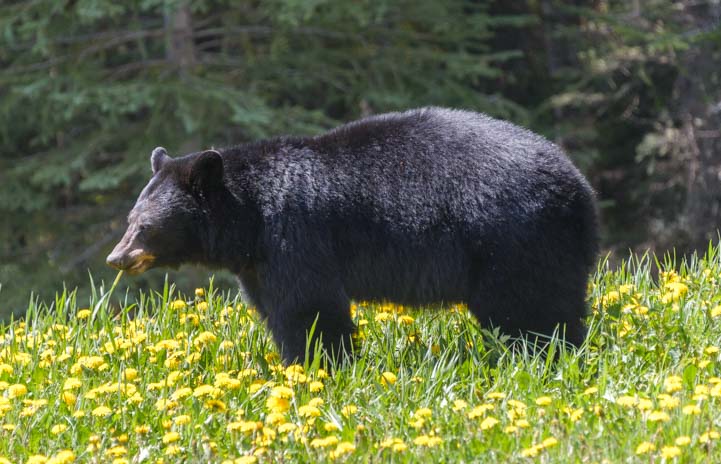
Hey, there he is – a black bear in the dandelions right next to the highway!
We hadn’t gone but a few miles further when we spotted a big brown bear munching away in the grass too.
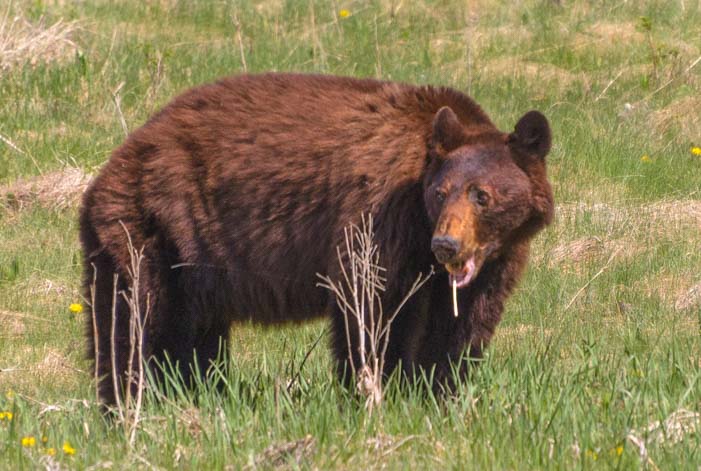
Another bear by the highway! Wow!!
We slowed to get his photo and he stared right at us.

Wow. We hadn’t been in the Canadian Rockies very long or gone on any epic hikes, and we’d already seen big horn sheep and bears!

.
The scenery continued to be beautiful as we drove north through Kootenay National Park.

The Vermillion River is actually turquoise!!
We stopped at Numa Falls and explored the rocky shoreline of the Vermillion River.

The rocks at Numa Falls have been carve by the water.

Rushing water at Numa Falls.
Kootenay National Park suffered three huge forest fires in recent years, and we did a short hike into the burned forest where young trees were just getting started between their scorched ancestors.

Huge forest fires in Kootenay National Park wiped out the old trees, but here come some new ones!
It was eerie to walk among the tall and skinny trunks of what was once a thick forest of huge trees. In between the charred trunks, young trees were starting to create a new forest.

Ghosts of towering pines stand next to saplings that are starting a whole new forest.
A little further along on Highway 93 we saw a sign that said, Paint Pots. This sounded intriguing. We stopped and followed the hiking trail to a stream, but had no idea how far down the trail these paint pots were or even what they were. Other hikers coming towards us told us they were just a little further on, so we kept going over a bridge. But then the trail forked.
Luckily there was a sign, but apparently the sign makers forgot to include directions to the Paint Pots! So, someone had written it in. Another hiker had written, “Thanks.” Yes, indeed!

Parks Canada left “Paint Pots” off the sign, but a helpful hiker wrote it in. Nice!!
The Paint Pots are vividly colored muddy puddles, and we walked between them — on a boardwalk sometimes — marveling at the bright orange hue.

Brightly colored waters at the Paint Pots.
In earlier times, the Indians had used this colored water to paint themselves. In more modern times someone painted a heart on a tree!

“Paint” from the paint pots works great on tree trunks!
Just up the road we stopped to hike at Marble Canyon. Bright turquoise water filled the canyon at the base. Further up we found a rushing waterfall.
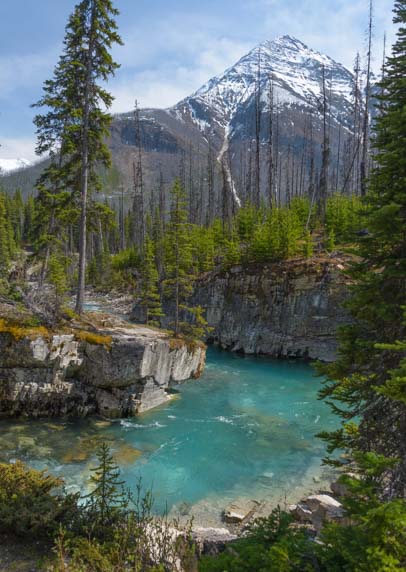
Marble Canyon’s turquoise water shows off the rocky cliffs, green trees and snowy mountains beautifully.
Parks Canada has placed pairs of red chairs throughout their National Parks in scenic spots, inviting visitors to have a seat and enjoy the view — and take a selfie. At the end of the trail into Marble Canyon we spotted a pair of red chairs and did just that.

We found a pair of the famous Red Chairs at the end of the Marble Canyon hike.
There are lots of other hikes and things to see in Kootenay National Park, not least of which is to take a dip in the magical Radium Hot Springs (more on that in a future post), but we were excited to get up to the true heart of this awe inspiring area, Banff National Park, which is just up the road from Kootenay National Park.
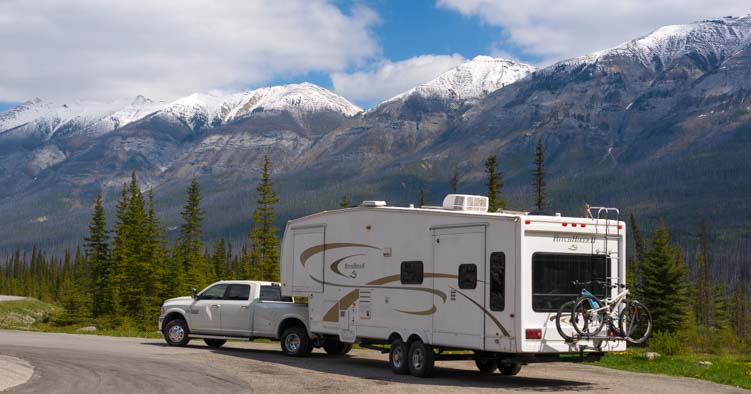
The buggy posed for us as we took pics of the incredible mountain scenery.
Subscribe
Never miss a post — it’s free!
More info about Kootenay National Park:
- Kootenay National Park Official Website
- Parks Canada Annual Discovery Pass Info
- Our route through Kootenay National Park on Google Maps
Related posts from the Canada and the Rockies:
Tips for RVers Traveling to Canada
Blog posts from our RV travels in Canada
- Waterton Lakes Nat’l Park – Starry Skies, the Milky Way & Wildflowers
- Waterton Shoreline Cruise – A Classy Tour of Waterton-Glacier NP
- Waterton Lakes National Park – Rocky Mountain High!
- Kananaskis Country – Canadian Rockies Beauty Off the Beaten Path
- Canmore, Alberta – An Outdoor Lover’s Town in the Rocky Mountains
- Jasper National Park – Columbia Icefields & Athabasca Falls
- Hot Springs in the Canadian Rockies – Swimming in Giant Hot Tubs!!
- Banff, Alberta – A Grand Resort Town in the Canadian Rockies
- Yoho National Park – Emerald Lake & Natural Bridge – Aqua Magic!
- Moraine Lake – Crown Jewel of Banff National Park
- Icefields Parkway – True Blue Lakes, Avalanches & Grouse!
- Icefields Parkway – Canadian Rockies Scenic Drive – WOW!
- Lake Louise – RV Travels to the Heart of the Rockies in Banff
- Canadian Rockies – Big Mountains & Bighorn Sheep!
Our most recent posts:
- How to Install Starlink Gen 3 in an RV? Use the Speedmount! 08/07/25
- Escape to Paradise – Rocky Mountain Magic! 08/01/25
- Is Forest River a Good RV? Well Built? Here’s Our Experience 06/20/25
- Sunset Crater Nat’l Monument – Lava & Camels at Bonito CG! 06/06/25
- 2024 Alpha Wolf 17CB Trailer – Our Goldilocks RV! 04/25/25
More of our Latest Posts are in the MENU above.
<-Previous || Next->

Another Great blog, gorgeous pictures. Must visit someday. Thank you for sharing.
You’re welcome… our pleasure..
Such a beautiful place. Love the t shirts.
🙂
Absolutely spectacular! That turquoise river is incredible, and your bear sightings….wow! Kootenay National Park has been on our radar for a while now—we just need to pry ourselves away from our summers in the San Juan Islands. This post just might do it…..
We’ve never been to the San Juans other than a ferry ride, but I can imagine it is beautiful. But one season or month or week in the Canadian Rockies is well worth it!!
We really enjoy your wonderful blog – we’re full-time (boat) cruisers in Alaska and are just getting a 5th wheel RV in a few months for off-season exploration.
By the way, the brown bear you photographed is not a true “brown bear” (aka grizzly) – it’s a brown colored black bear, sometimes known as a “cinnamon” bear. You can tell the difference between black bears and grizzlies by the shape of their head (the grizzly has a very “dished” face) and the large hump of muscle between their shoulders.
Singing, talking loudly and clapping are the best ways to alert bears to your presence when hiking in bear country.
Thank you for reading our blog during your boating travels in Alaska, Robin, and for your info about bears. We wish we’d seen a grizzly during our Canadian Rockies travels this year, but unfortunately “cinnamon” was as close as we got. Enjoy your fiver in the off-season!